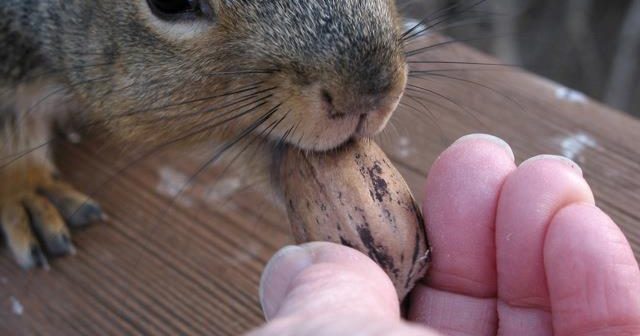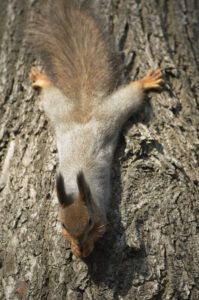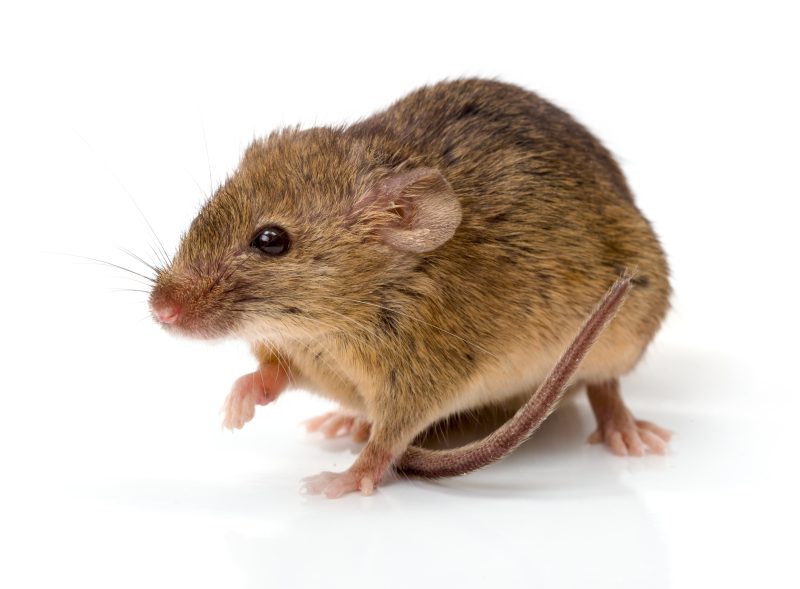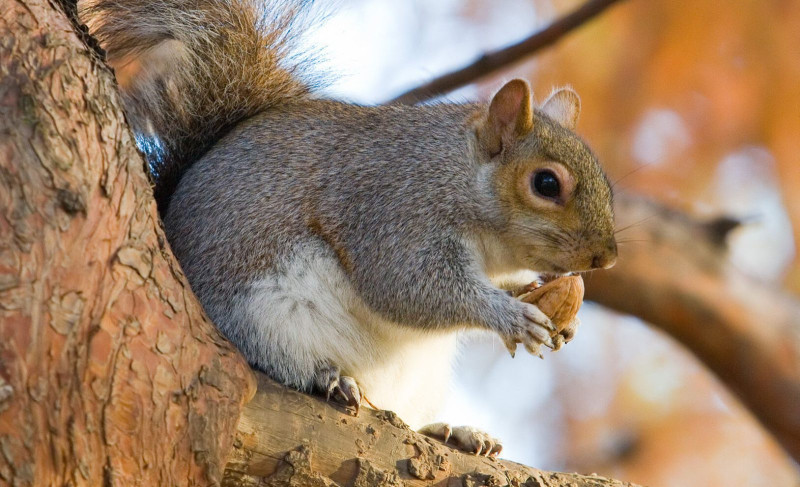Is it OK to feed squirrels?
Absolutely. Offer them black oil sunflower seeds or peanuts (shelled or unshelled). They’ll also eat dried whole corn (on or off the cob). They’ll help themselves to about everything you put out for birds, too. This frustrates some people, but others enjoy “their” squirrels. When not being fed by people, squirrels eat berries, flowers, and grains, but their most important foods are the hard ones, such as nuts and seeds. Tree bark, too—it offers nutritional value, but also because squirrels have four chisel-like, continuously growing front teeth that must be kept short. So, gnawing on hard food keeps them filed down. Lacking that, a squirrel will die of starvation as its teeth become too long and prevent it from eating.
I found a baby squirrel; what should I do?
If it has hair, stay away for an hour, while keeping watch. If the mother is going to retrieve her baby, she’ll do so as soon as she’s aware. If it’s hairless, the situation is more critical, but even then, keep watch for several minutes. Look to see whether it’s possible to return it to its nest, although most nests are out of reach. Keep the baby warm and get it to a licensed wildlife rehabilitator immediately.
Don’t feed it. Baby squirrels require a specialized diet and round-the-clock feeding. Warm a chilled baby by snuggling it in your hands. As soon as its body temperature is the same as yours, place it in a container with paper towels or soft cloth to serve as a “nest” (don’t use a material that unravels, such as a towel). Place a heating pad, set on low, under half of the box — this leaves the other half unheated in case the squirrel gets too warm. Closely monitor the heat.
Please don’t keep a squirrel as a pet. It’s a wild animal and belongs in the wild. In your home, it would require a very large cage and opportunities to be active to allay boredom. Out of the cage, it will chew your furniture, woodwork, and electrical wires, climb your drapes, knock over all your objet d’art, and be lonesome for others of its kind. You can read more about animal rescue here.
How do squirrels go down trees so easily?
Tree squirrels can move fast and nimbly all around a tree, even headfirst going down. What keeps them from falling? It isn’t their sharp claws, although they’re important. It’s their double-jointed ankles—they can turn their back feet completely around, allowing them to cling with their back claws even when heading down.
Can squirrels swim?
Yes. They’re good swimmers, in fact—they “dog paddle” with their front legs and use their tail as a rudder. But swimming is a very strenuous activity for them. If they fall into a swimming pool, they often can’t find their way out, and the slippery sides may prevent them from even clinging so they can rest. They may eventually drown.
To help a squirrel get out, use a pool net to scoop it up (or any other long-handled object it can grab). Keep hold of the pole and step backward. The squirrel will run right up the handle toward you, which may be alarming, but it won’t want to touch you. It will jump off as soon as it’s clear of the water. If it’s too exhausted to do more than just cling to the pole, then slowly lower it to the ground and step away. The scared and exhausted animal will scamper away as soon as it can muster the energy.
Why do squirrels strip the bark off of trees?
Sometimes, they’re just hungry and strip bark for food. They may also gnaw on bark to “file” their teeth. Squirrels are “rodents,” a word that comes from the Latin rodere, meaning “to gnaw.” And do they ever! But that’s because they have to—gnawing keeps the front teeth of squirrels and other rodents short and sharp. Thick enamel covers the front surface of the front teeth (incisors), but not the back. Consequently, the back surface wears down faster than the front, creating a chisel shape. Rodents gnaw with the incisors by pushing the lower jaw forward and chew with their back teeth (molars) by pulling the lower jaw backward.
How do squirrels survive in winter?
Tree squirrels prepare for winter in several ways. In the fall, they fatten up and grow a thicker coat. They bury nuts for eating through the winter. They build a good nest out of twigs, leaves, and any other insulating materials they can find, preferably within a tree cavity. When it’s really cold, they may share a nest for warmth. On very bad days, they may stay in their nest.






